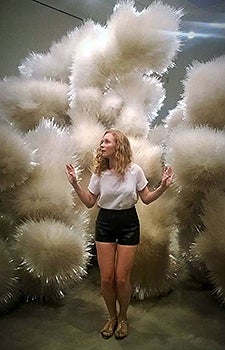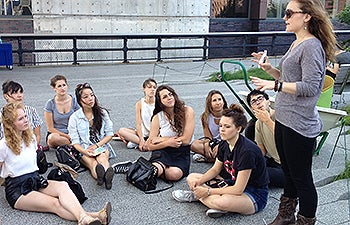Sweet Trip
In the abandoned Domino Sugar Refinery on the Brooklyn waterfront — an iconic New York landmark — a monumental sphinxlike sculpture made of white sugar gazed out impassively over the East River. This kerchief-wearing hybrid of two distinct racist stereotypes of a black woman — both caregiver and sex object — was a temporary installation by controversial contemporary artist Kara Walker.
Created as a memorial to the laborers who toiled in the factory, once the largest sugar refinery in the world, the artwork raises significant questions of power, gender, race, slavery, sexuality, sugar refining and consumption, wealth inequity and industrial might.
Walker’s work made a deep impression on the group of 19 USC undergraduates who viewed it during the Maymester course “Contemporary Art and Art Writing in New York” taught by USC Dornsife’s Suzanne Hudson, assistant professor of art history and fine arts. The class offers students an introduction to contemporary art and art writing, and insights into a wide range of careers within the professional art world.
The students gained a deeper understanding of Walker’s installation when they met with Laura Raicovich, director of global initiatives at Creative Time, the agency that sponsored the exhibition.
“I loved the way Walker used a factory as a backdrop for her social commentary,” said Olivia Poppens, an art history major, with minors in music industry and business.
Senior Feibi McIntosh, an art history major, agreed. “Public art plays such an important role in a bustling metropolitan environment. Creative Time’s exhibition created a well-thought-out and provocative artwork that touched upon what it means to reflect upon one’s location and be present in one’s environment.”

Art history major Carly Rustebakke at the Pace Gallery, in Chelsea, during a visit to Tara Donovan’s recent exhibit.
Hudson said the program — now in its second year — grew out of her dissatisfaction with the limitations of how art history can be taught in the classroom and her desire to immerse her students in the art world.
“Until students are immersed in that world, they don’t have the same understanding of it,” she said. “Galleries can seem like prohibitive, inaccessible spaces, and museums entirely abstract.”
Hudson wanted the course to emphasize the value of critical thinking and effective communication: “I encourage them to acknowledge their powerful role as interpreters and producers of culture, not just as consumers.” She also wanted to show students the myriad career possibilities available to those with an art history degree.
During the trip, meetings with art professionals — from critics and editors to curators and educators — offered a range of opinions that informed group discussions and provided insights into what these kinds of jobs entail.
Hudson said she was surprised this year by the number of students who enrolled with specific visions of jobs that interest them in the art world.
“There are certain jobs like being a curator or a museum educator that people tend to know about, but what surprised me this year was the number who said, ‘I want to work at an auction house in a specific city, or in art PR or art publishing,’ ” she said. “To me, that indicates a larger professionalization within the field, but also a shifting recognition of the viability of these careers within art history at USC.”

At the Metropolitan Museum of Art, students discuss the work of artist Dan Graham with museum curator, Ian Alteveer.
During their three weeks in New York, students visited the Museum of Modern Art, the Jewish Museum, the Brooklyn Museum, the New Museum and the Guggenheim Museum, where they attended a discussion of the recent Futurism show with curator Susan Thompson.
At The Metropolitan Museum of Art they met associate curator Ian Alteveer, who gave them a guided tour of the pavilion created by artist Dan Graham for the museum’s roof garden.
At the Whitney Museum of American Art, students toured the biennial show and met with Kathryn Potts, associate director and chair of education. From Potts, students learned about the museum’s long-term goals as it prepares to relocate to the Highline from the Upper East Side. Potts also spoke about the ideology of a museum devoted to American art in a global era.
Students also visited Chelsea galleries and the Lower East Side, explored SoHo galleries and enjoyed a studio visit with artist Nathlie Provosty. They met owners Simone Subal and Alexander Dumbadze at the Simone Subal Gallery and visited the Neue Gallerie, where they toured the Degenerate Art show and discussed private philanthropy.
During the course, students participated in seminars introducing them to the history and practice of writing about contemporary art. Beginning with historical criticism, they investigated more recent discourses around modern art, analyzing numerous outlets for criticism, including online formats, newspapers, magazines and monographs. To that end, they met with New York Observer art critic, Maika Pollock; Phong Bui, publisher of Brooklyn Rail; and Lauren O’Neill-Butler, critic and editor of Artforum.com.

Alicia Dewell, a narrative studies major, presents to fellow students on the history of the New York Highline.
“Unlike most university-level courses, which require students to write long papers, I ask them to write very short pieces, similar to the actual word counts required when writing art criticism for established publications,” said Hudson, herself a longtime critic for Artforum.
“However, there is an elaborate peer review process for each assignment. So although these assignments are relatively brief, the student may rewrite a given piece five or six times. In the process, they are learning to edit other people’s work while assimilating this editorial process so they can autocorrect their own work in the future.”
“My writing improved tenfold,” Poppens said. “Professor Hudson instilled the importance of peer editing and drafting papers over and over again to get them as close to perfect as possible.”
Hudson noted that the skills the students practice through art history are translatable for any form of work or scholarship.
“To be able to communicate ideas effectively in a concise format that is still argument-driven is what we all hope our students have mastered when they graduate,” she said.
Hudson said the Maymester class had been an overwhelmingly positive experience for the students.
“I think many of them came away with a much clearer sense of how they could use an art history degree, or how they could think about their own skill set in relationship to an industry with which they feel an affinity,” she said.
McIntosh said the course made her realize she doesn’t have to pigeonhole herself into traditional art history pathways like a museum curator or gallerist.
“I can explore interactive museum education or creative marketing for a nonprofit, while also writing art criticism for Artforum,” she said. “After this Maymester, I understood I have more options than I initially believed, and this realization has provided me with a more hopeful future post-graduation.”